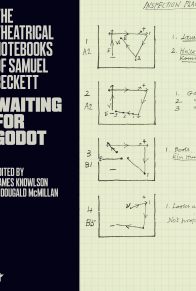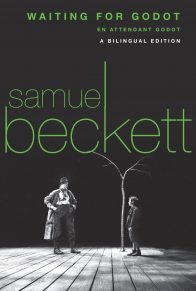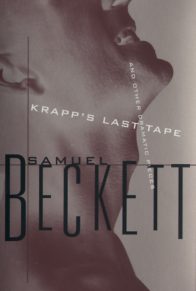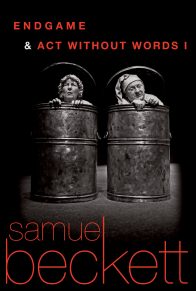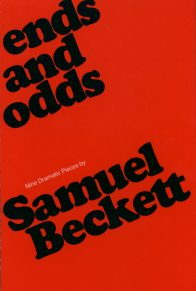A paradox lies at the core of Samuel Beckett’s creative enterprise. Arguably the preeminent avant-garde writing of the post-World War II era, a period we loosely call “postmodern,” Beckett’s work is equally the culmination of the Romantic agony; he is at once the emblematic deconstructive author and the heir to Kant and Schopenhauer (despite their emphasis on the phenomenal world), if not to Hume. In other words, his celebrated innovation and his assault on literary convention are themselves rooted in discernible literary and cultural traditions, as much pre- as postmodern, his sensibility reaching back to the classical–that classicism leavened by both late Romanticism and post-humanism.
His celebrated aporia finally may be as rooted in pre-Socratic as in poststructuralist thought.
One useful starting point for reading Beckett, then, may be Beckett’s own reading, particularly those works he read as he struggled to invent himself as a writer, among them: William Inge’s Christian Mysticism (1899); John Burnet’s Early Greek Philosophy (1892) and Greek Philosophy (1914); Robert Burton’s The Anatomy of Melancholy (1621); Mario Praz’s The Romantic Agony (1930); and Wilhelm Windelband’s A History of Philosophy (1892 and 1900). The ghostly, disembodied, externalized voices of Beckett’s late fiction and drama, arguably his most profound literary creations, derive initially if not primarily from the myth of Echo and Narcissus. (The electronic projection of the disembodied voice developed by Marconi and the internal discourse of fragmented Jungian or Lacanian ego thus are afterthoughts.) His ontology, a sense of discontinuous being or lack of fixity of any sort, owes as much to the contretemps between Heraclitus and Parmenides as it does to post-Freudian psychoanalysis. Heraclitus’s emphasis on a world of becoming, a liminal world in perpetual transition, reverberates through Beckett’s work where to utter “now” is always late, an afterthought, consciousness itself always belated. To utter “I,” then, is inescapably retrospective, a corrupt distortion of memory, nostalgia for a present moment, as Kant suggested, always inaccessible to empirical consciousness. Moreover, while the cultural dislocation, alienation, and the dehumanization of the Shoah that blight the twentieth century dominate his art, it retains a remarkable if surprising coherence, his works forming part of a continuous series, if not a pattern.
As early as 14 May 1947, for example, in the midst of an explosive creative period he called “the siege in the room,” Beckett detailed that continuity to friend and sometime literary agent George Reavey. Of Watt in particular he confessed, “It has its place in the series, as will perhaps appear in time”; and on 8 July 1948 he elaborated on that design: “I am now typing, for rejection by the publishers, Malone meurt, the last I hope of the series Murphy, Watt, Mercier & Camier, Molloy, not to mention the 4 Nouvelles & Eleutheria (Lake, 53). Malone meurt was, of course, not the end, the series (progressive or regressive) merely slowed by the author’s corporeal demise in December of 1989, Beckett apparently still publishing from au del”: Dream of Fair to Middling Women in 1992, Eleutheria in 1995, as well as a series of notebooks and letters, all of which begin to constitute something like a gray canon of his work.
Throughout that series his creatures peopled what critics began to recognize as a distinct terrain, the Beckett country. It is a premodern world where bicycles outnumber motorcars, where theaters are lit by footlights, where clothes are fastened by buttonhooks, where parents still pass on family greatcoats and bowler hats to their offspring, hats tethered to coats1–a world of chamber pots, which put humanity in greater proximity to evacuation, and oil lamps. Beckett’s roots reside firmly in turn-of-the-century turf, amid the Anglo-Irish bourgeoisie. It is a propertied world, where possession assured not only propriety but existence as well, a world whose dictum may have been, “I own, therefore I am.” The residue of that tradition remains traceable in Beckett’s work, the Ascendancy Big House having become Gothic in Watt and Footfalls. Beckett’s creatures retain a curious, antibourgeois relationship to possessions or property, of course. They simultaneously seem obsessed by and strangely neglegent of them or it.
Beckett’s critique of that tradition includes the treatment of the body as possession, property about which his characters are often as careless as they are about their other chattels. As in much eighteenth- or nineteenth-century fiction, Beckett’s characters are often expelled from a world of consequence, and thus become inconsequential. Beckett played with that materialist tradition, like Mr. Kelley and his kite, to the point of immateriality, his characters dispossessed of their property and the ownership of their bodies, hence the emergence of ghostlike, neo-Gothic figures like May in Footfalls and her unnamed echo in Ill Seen III Said. The issues of property, of possession and dispossession, thus shift to the subjectivity of being. If one is defined by one’s things, Beckett’s characters slip or are pushed into a world of no thing, an immaterial world where even language, one’s narrative voice, or its physical manifestation in writing, are beyond possession.
Beckett finally rejected bourgeois Dublin for bohemian Paris, there championing the antifigurative painting of intimates like the brothers van Velde, Bram and Geer. His own art, however, reflects less such priestly moderns than figurative painters who might have been perfectly acceptable to Dublin’s Anglo-Irish Ascendancy: Rembrandt, Caravaggio, and, perhaps most important, the German Romantic Caspar David Friedrich, one version of whose Two Men Contemplating the Moon (or its corollary A Walk at Dusk, with its megalithic stone tomb juxtaposed to the moon2) is echoed in the visual imagery of Waiting for Godot. Krapp’s Last Tape may in turn take its visual cue from Rembrandt’s The Parable of the Rich Man or The Money Changer of 1627, which Beckett saw, as noted in his Berlin diaries of 1936–37, in the Kaiser-Wilhelm-Friedrich Museum in Berlin in 1937.3 He had been mulling such spotlight effects as dominate Krapp’s Last Tape and the late plays as early as 1932 when he bought, on Thomas MacGreevy’s advice, a copy of R. H. Wilenski’s An Introduction to Dutch Art (1929). Of particular note for Beckett was Wilenski’s discussion of “the Caravaggio-Honthorst tradition” of spotlight effects, particularly in the painting of Gerrit van Honthorst, dubbed “Gherardo delle notti,” whose candlelight studies such as Boy Singing by Candlelight or Girl Catching a Flea in Her Nightdress are in the Doria Gallery in Rome.
In 1935 Beckett was discussing the technique with MacGreevy: “The Geertgen Adoration must be one of the earliest spotlight paintings. Surely it is only half the story to date them from Raphael’s Liberation of Saint Peter. I never saw the Oxford Uccello mentioned in this connection either” (letter to MacGreevy, 20 February 1935). Beckett’s spotlight theater, like the disembodied, suspended lips in Not I, owes less to radical surrealist iconography like Man Ray’s dreamscape A l”heure de l”observatoire–les amoureaux, with its liberated flying lips, or the grotesque, divan-sized lips of Salvador Dali’s Mae West Lips Sofa than to the Renaissance imagery of Caravaggio’s Decollation of John the Baptist. Beckett saw the painting at La Valletta Cathedral while vacationing on Malta in October of 1971. “The idea of having only a mouth on stage,” notes Anne Atik, wife of painter Avigdor Arikha, in her memoir of Beckett’s last years, “preceded his trip to Malta, but once there, Sam was deeply impressed by the dichotomy in the composition of the Caravaggio: the decapitated figure on the left and the curious but indifferent onlookers on the right” (Atik, 4). James Knowlson has observed that the position of the ghostly May’s arms in Footfalls may echo Antonello da Messina’s Virgin of the Annunciation, which Beckett saw at the Alte Pinakothek in Munich (Knowlson, 552), and Arikha finds echoes of Gerard Terborch’s Four Spanish Monks, with its black hat on a table, a painting that Beckett knew from the National Gallery of Ireland, in “Ohio Impromptu” (Atik, 6). Musically, while Murphy’s heart may have been “Buttoned up and left to perform [“] like Petrouchka in his box,” composers of note for Beckett were not the likes of Stravinsky but the German Romantics, Beethoven and Schubert. Maddy Rooney hears Schubert’s String Quartet #14 in D minor, Der Tod und das M’dchen (Death and the Maiden), at the opening of his soundscape–a work that challenges the tyranny of the eye in art–the radio play All That Fall, and it was Schubert’s final song cycle of 1828, Winterreise, that Beckett used to shape his own theatrical Schwanengesang, “What Where.”
The humanist idea of authorship that Beckett both epitomized and felt imprisoned by was central to his creative makeup. He was among the last of the twentieth century’s major authors thoroughly immersed in canonical European literature, and his memory was nearly eidetic. His was an elite, Ascendancy, Anglo-Irish education that even Joyce envied, and one that he continued as an autodidact. He had at his ready command, even in his later years, not only all of Shakespeare, Dante, Milton, Petrarch, the King James Bible (not to mention the Book of Common Prayer), and much of English and German Romantic poetry (Goethe, Heine, and H”lderlin, in particular), but Sterne, Defoe, Flaubert, and Yeats, as well as Dr. Johnson and his commentators (he owned The Poetical Works of Samuel Johnson, 1785, a 1799 edition of the Dictionary, and the six-volume Birbeck Hill edition of Boswell’s Life of Samuel Johnson). He could quote easily from Burton’s The Anatomy of Melancholy (his a three-volume edition) and St Augustine’s Confessions. He owned a compact OED, which he consulted regularly, and Anne Atik recalls his defense of arcane or obsolete language like “wearish” in Krapp’s Last Tape; “feat” in Footfalls; “haught” in “What Where” and Ill Seen III Said (Atik, 25, 56); and ‘strangurie” in Ill Seen Ill Said. Such words, like his characters themselves, become cultural ghosts, the language rupturing the present to disclose the space of cultural memory. Beckett’s allusions in general, fragmentary and submerged in the later work, function thus, as cultural traces. In I960 he was “learning Matthias Claudius by heart! “Friend Death”” (Atik, 65; her translation). Schubert had adapted Matthias Claudius for his lied Der Tod und das M’dchen, a song that features a young girl frightened by a ghost, the shadow of death. That ghost haunted Beckett’s own 1969 (and so subsequent) staging of Krapp’s Last Tape as the wearish Krapp periodically senses the haunting Hain behind him.
The richness of his education may finally have burdened Beckett as the European eidos permeated his being and haunted his consciousness to the point that much of his early work might be seen as pastiche. Beckett seemed to be working through what Roland Barthes in his seminal essay “The Death of the Author” described as “tissues of quotations drawn from the innumerable centers of culture.” The more we know about those “centers of culture” on which Beckett drew, the more fully we understand Beckett’s technique–much of which developed through what Knowlson has called a “grafting technique” –and, moreover, the more direct resemblance we find to methods of composition employed by Beckett’s fellow Dubliner James Joyce.
Joyce took particular care with his research, reading books primarily for what they could offer him for his own writing. (Indeed many people who knew him, including Beckett, have claimed he read almost exclusively for this purpose.) Though he was inspired more by disinterested intellectual and scholarly curiosity than Joyce was, Beckett’s notebooks show that he too plundered the books he was reading or studying for material that he would then incorporate into his own writing. Beckett copied out striking, memorable or witty sentences or phrases into his notebooks. Such quotations or near quotations were then woven into the dense fabric of his early prose. It is what could be called a grafting technique, and at times it almost runs wild. He even checked off the quotations in his private notebooks once they had been incorporated into his own work. (Knowlson, 109)
One plausible explanation for Beckett’s linguistic flight from English to French was his desire to evade those “centers of culture,” to write, as he said only half jokingly about this change, without style.4 His was an education with which he struggled during his early years in Paris, simultaneously admiring what Joyce did with his but uncomfortable about it for his own work, shunning the implications of mastery. After the Second World War Beckett would jettison the virtuosity of modernism (along with the English language, for a time), banish its blandishments, shun literariness for a linguistic literalness often confounding in its simplicity. Yet his work remained extraordinarily allusive and intertextual, his referentiality becoming less overt, less showy in the later work.5 Even as he struggled to free himself from what he called, in his 1934 poem “Gnome,” “the loutishness of learning,” he could still in 1968 dictate to Anne Atik from memory long passages from Boccaccio’s lectures on Dante, particularly those on the allegory of the peacock (Atik, 79–81). Education for Beckett remained the sticky paper he could not quite shake from his boot. Yet too few critics have focused on the scope of Beckett’s canonical immersion, his borrowings, his allusiveness, his debt to an intellectual tradition he was simultaneously struggling to dismantle. He retained a curious nostalgia for that tradition, his idea of authorship and the literary life shaped as much by Samuel Johnson as by his early mentor Joyce.
While a distinct Beckett country is discernible, its lineaments are not always discrete, and as a result few maps chart its terrain. A comprehensive cartography, its atlas, say, remains to be written–one that includes his life (since it impinged so dramatically, if obliquely, on his art), his reading (since it has informed his art incalculably), his thought, for want of a better word (since despite protests to the contrary his art is imbued with and informed by the philosophical, ontological, linguistic, and cognitive cruxes of his and earlier ages). Like Thomas Hardy and the southwest counties he called “Wessex,” or like Graham Greene and his “Greeneland,” or even William Faulkner and his Yoknapatawpha County (writers with whom he shares little else), Beckett has shaped a recognizable country. Hardy, Greene, and Faulkner provided their own atlases. Yoknapatawpha County, for instance, encompasses 2,400 square miles of territory with distinct boundaries and a frozen population: 6,298 whites and 9,313 “Negroes.”
Moran associates the Beckett country with his shadow or alter ego, its boundaries, indistinct as they are, seemingly inviolable: “By the Molloy Country I mean that narrow region whose administrative limits he has never crossed and presumably never would” (Three Novel, 133). Such may be the territory finally of the self (so called), to which Moran and the host of omnidolent moribunds who inhabit the Beckett country are also bound. Beckett played the cartographer briefly with an exceptional novel, The Lost Ones, mapping a corner of that frozen world: 205 creatures inhabiting an issueless cylinder sixteen meters high, with a total surface area of 12 million square centimeters. But The Lost Ones charts its macrocosm, the phenomenal world; it is a mural image, finally, an outline for the late closed space fictions.
The Beckett landscape is finally more amorphous, more porous, more mutable, and considerably less populated than Wessex, Greeneland, or Yoknapatawpha County. It is, as he put it in his French poem of 1947, “bon bon il est un pays,” “un pays sans traces,” a pathless, borderless land associated more with mental than phenomenal terrain. It is a seeming land, never quite present to us–the land a specter, its population ghosts. As the French title for The Lost Ones suggests, this is a depopulated or de-peopled land. Even Beckett’s celebrated Ireland is an impression, a dreamscape without presence, a land without soil, say, just as the book, the page, or the stage are always only images, as witness the late masterwork Ill” Seen Ill Said. And so the Beckett country may finally be more simulated than geographically discrete, simultaneously anywhere and nowhere, marked by what Jean Baudrillard calls “hyperreality,” where signifiers obliterate signifieds and language becomes less external than self-referential. This, then, is what we tend to call the postmodern Beckett, his world one in which models, codes, myths, words themselves float free, having lost touch with or broken from their origins, foundations, and points of reference. In Baudrillard’s splendid inversion of causality, “It is the map which precedes the territory. [“] It is the map that engenders the territory.”6
Eoin O’Brien has come as close as anyone to mapping the physical terrain of Beckett’s Ireland, but the territorial, geographical limit is at once the strength and weakness of his monumental achievement, The Beckett Country (1986). It stops short of showing us how Ireland is absent or disappears from Beckett’s work, how it exists as an afterthought, an aura, which is a specter with its subject gone. Despite his Irish roots and recent attempts of countrymen to recolonize him, Beckett was a consummate European, more comfortable in the intellectual milieu of Europe than that of his native “prosodoturfy.” Much of the psychological landscape has been meticulously detailed by James Knowlson in his incomparable Damned to Fame: The Life of Samuel Beckett (1996), which fully takes the measure of the man and opened innumerable avenues of investigation for subsequent scholars. Most immediately, the biography has provided the impetus for books like John Pilling’s edition of Beckett’s Dream Notebook (1999) and his subsequent annotations to the novel in A Companion to Dream of Fair to Middling Women (2004), and for C. J. Ackerley’s Demented Particulars: The Annotated Murphy (1998). J. D. O’Hara has obsessively detailed Beckett’s own obsessive use of sources in Samuel Beckett’s Hidden Drives: Structural Uses of Depth Psychology (1997). More recently Ruby Cohn has again taken us on a personal exploratory voyage through A Beckett Canon (2001), covering in detail the work in sequence, published and not, uncovering further interconnections and so the continuity of the whole. The Grove Companion builds on these works (among others) in its attempt to chart the spectral territory more fully, to plot the crossroads, byways, and lanes of Beckett’s intellectual landscape. Much of that imagined terrain comprises canonical European literature and the discourse surrounding it. Dante, Shakespeare, Dr. Johnson are finally as integral to the Beckett country as are the Dublin mountains. The complexity of the Beckett country may doom all mapping expeditions to failure, a result Beckett himself flaunted in his work and taught us all to accept in our own enterprises. The best one can hope for is a rigorous attenuation, like that found in the fragmentary late works where completeness remains beyond possibility, absence of ending (hence of conclusion) evident in the works from Godot onward and signaled more directly in the radio plays “Embers,” “Words and Music,” and “Cascando’–each of which Beckett called a piece for radio–the Roughs for Radio I and III and for Theatre I and II, From an Abandoned Work, “A Piece of Monologue,” and, of course, the Fizzles, among others.
The overall purpose of The Grove Companion is, nonetheless, to guide serious readers through the Beckett terrain. Its range of entries is designed to allow a reader to check on a word, allusion, or idea in the midst of reading, or to pause and contemplate in the longer, essay-length entries more complicated philosophical cruxes and historical oddities that Beckett cites and explores, or to wonder at the extent of his references to the Bible and Dante, to music and the visual arts. Many of the issues detailed herein extend far beyond Beckett’s work per se. The aim is to situate it (and him) within a tradition that spans classical to modernist ages. More broadly and more boldly our aim is to alter the way Beckett is read, or reread, to suggest that Beckett’s work is not the exclusive domain of students and scholars as we comment on, even as we often cannot completely resolve, some of the central cruxes, correspondences, and allusions that dominate his thought and so his art. These are often issues of broad intellectual, cultural resonance. Writing for Beckett was always a haunting echo of memory, personal and cultural. Learning to read Beckett, again, is to approach him as already a repetition, an echo of his reading, of his culture, and finally of himself. Reading, as we see in the late masterpiece Ill Seen III Said, is itself an aftereffect, a repetition that is never the same, a version of eternal return that Joyce called in Finnegans Wake “The seim anew” (215). We hope that the arrangement of material makes the volume browseable as well and that such browsing leads the reader continually back to Beckett in a series of loops that will always remain “The seim anew.”
S.E.G.
C.J.A.
©2004 by C. J. Ackerley and S. E. Gontarski. Reprinted with permission from Grove Atlantic Inc. All rights reserved.





